Whenever a reader asks for help in finding a recipe, I do my level-best to hunt one down. When Devyn asked for a bread recipe called Bokon, I thought I’d found it, but unfortunately, no. So Devyn’s next request was for Matnakash, another bread recipe that might be closer to what she’s looking for.
I exhausted my personal resources when it occurred to me to check “The Art of Armenian and Middle Eastern Cooking” on Facebook. I made a request for the recipe, and within minutes, one appeared.
Devyn, after you try the recipe below, please report your findings to us. We’re anxious to know if this is your lost bread.
” ARMENIAN BREAD – MATNAKASH “, recipe from “The Art of Armenian and Middle Eastern Cooking” on Facebook
( A Symbolic ARMENIAN Bread )
Their Facebook page said, “The secret behind this recipe is simply good kneading and proofing of the dough.”
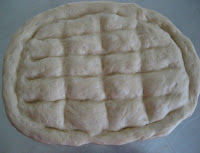 |
| Before baking |
INGREDIENTS:
500 g bread flour (see Robyn’s notes)
350 g warm water (see Robyn’s notes)
3 tablespoons extra virgin Olive Oil
PREPARATION:
In a bowl, pour warm water, add all dry ingredients and knead the dough about 20 minutes.
Cover the dough with a clean towel and let it rise in a warm place for about 1 hour.
Moisten your hands with water, punch the dough lightly and stretch and fold four times. Then cover it again and leave it in a warm place for another 30 minutes.
Divide the dough into 2 equal parts.
On a large open pan, pour the olive oil and stretch open the dough (one at a time) into an oval shape – making sure both sides are covered with oil.
Let it sit for another 15 – 20 minutes.
Meanwhile, pre-heat oven to 425 degrees F.
Fold all along the rim of the oval breads and wrap them gently/tuck them in.
With a fork or a knife (or finger if you wish to try) , gently give the appropriate design of a plowed field – 5 to 6 lines length-wise and 3 to 4 lines crosswise.
Place the Matnakash on a clean baking sheet and bake them in the pre-heated oven until golden brown (about 20 minutes).
Makes 2 Matnakash Loaves
Robyn’s Notes:
1. I attempted to convert the measurements for the bread flour and water into standard American units, and got the following approximate amounts: 500g bread flour = about 5 cups; 350g water = about 1 1/2 cups
2. Ingredient measures I actually used for the dough recipe:
5 cups bread flour
2 cups warm water (about 105 degrees F.)
1 package active dry yeast (instead of 1 tsp.)
1 tablespoon salt
3. I used the Kitchen Aid mixer with dough hook attachment to knead the dough – about 3 minutes until dough was smooth and elastic.
4. I lightly oiled the bowl used for proofing the dough.
OUR RESULTS: Never having made or eaten matnakash before, I had no measure of comparison. We did, however, really enjoy the final product – especially with Armenian string cheese, olives and a cup of strong coffee!


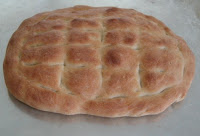
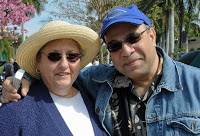
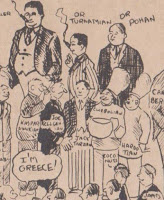
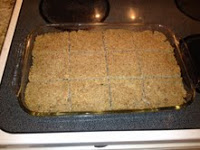
Hi again, Robyn!
This was DELICIOUS!! I have to say, I think we may have hit the nail on the head. It is more like perhaps a homemade version (as opposed with something more commercial) of bokon. Honestly, it's hard to tell because it was just that good!
In my own research on the matter, I contacted my grandmother who says that everyone she knew referred to the bread I was after as bokon, (she'd never heard of matnakash)and that often times it was used as a base for pizza.
Either way, I'm happy with this bread. Thank you so much for your efforts!
That said… have you a good recipe for gata?
Best,
~Devyn
Ooh, nevermind! I see you have it listed under katah. 🙂
Devyn,
I'm SO glad you liked the recipe! (We really liked it, too!)
Now that you've found the katah (gata) recipe, I'm hoping you'll make it and share your thoughts about that as well.
Happy Baking!!
One more thing! I just received a call from my grandmother, who received a call from another friend of hers, and she put me in touch with a bakery in the area. I gave them a call and they were well familiar with bokon and said that bokon and matnakash are the same thing. So the mystery is solved and it left me with a FAR better recipe for it than I could have picked up in the store. Thank you, thank you!! And yes, I will get to the next recipe. It sounds delicious!
if i dont have bakers flour what flour can i use instead? i really want to make madenkash for my husband who is from armenia too and we really miss the flavours of our homeland
Just to clarify, this recipe will make two loaves, correct?
Yes, that's correct…2 loaves. Enjoy!
interessantissimo sito!!! bellissimo questo pane!
Sandra
How is this bread different from the puffy flat loaves we learned of as "tohp-hatz"?
Pete,
Perhaps 'tohp hatz' is no different from matnakash. Many Armenian recipes go by different names based on the region from which they came. I searched through my Armenian cookbooks (more than 2 dozen!) and did not find any recipe for 'tohp hatz'. Do you happen to know the regional origin of this recipe?